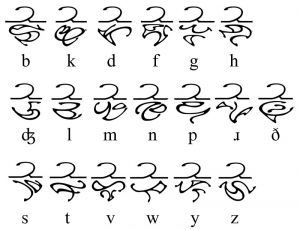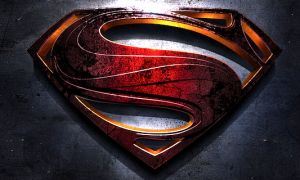Comics /
Spotlight
Superman’s Kryptonian Language in the Man of Steel Movie: A Medium Theory Analysis
By
Hervé St-Louis
December 31, 2013 - 13:39
Many Superman fans know that the letter S symbol on his chest is actually a Kryptonian word that both signifies the concept of hope and the family house of Jor El, Superman’s father. In the
Man of Steel, writer David Goyer and production designer Alex McDowell took this established concept from the comic books and went further. They hired linguistic anthropologist Dr. Christine Schreyer to help them craft an entire Kryptonian language starting with the Superman symbol. They explain much of this in the Blu-Ray release of the Man of Steel. While fascinating, there is even more that can be said about Kryptonian language and society if one borrows from medium theory, a subdiscipline of communications studies.
In the Man of Steel special features Blu-Ray, designers mention how writing influenced the concept design and story philosophy of the world of Krypton in Zack Snyder’s reinvention of the Superman myth. The problem, as they explained, started when they had to explain the meaning of the big S symbol on Superman’s costume. When cartoonist John Byrne reinvented Superman in 1986, he established that the crest Superman wears is a discursive symbol that has meaning beyond being a logo for a super hero. This inspired Man of Steel creators such as graphic designer Kirsten Franson to explore the linguistic features of the symbol and further integrate it in their story. In the Man of Steel, every inscription on artifacts and architecture has meaning. From the Superman symbol, a whole language was created with varying designs of cursive letters allowing whole sentences to be crafted and used.
The language developed by Schreyer started with the glyph used for hope. From there other glyphs were developed for other families. The Kryptonian language developed by Schreyer is phonetic, although every term has a specific meaning. This is intriguing as the suggestion that a glyph like Superman’s S has a specific meaning entails that it is more a logographic language as opposed to a phonetic one. Phonetic languages, like English and French render sounds closely with their scripts. But languages such as Chinese, Japanese and Korean are based more on the deciphering of a logograph which signifies a specific word or concept. Based on Schreyer’s assertions, she created in her rendition of Kryptonian both a phonetic and a logographic language for the Man of Steel movie.
One aspect of the Kryptonian language used in the Man of Steel is how it decorates and is inscribed on everyday and ceremonial artifacts and architecture on planet Krypton. For medium theorists, this is an important characteristic that tells a lot about the people of Krypton. Medium theory is an approach to communication studies that stems from the University of Toronto and the work of several of its world-famous academics like Harold Innis and Marshall McLuhan. Medium theory postulates that how people communicate using media, influences their politics and social-economic organization. Medium theory is often referred to as the Toronto School of Communication.
Political economist Harold Innis stumbled into medium theory when he wanted to explain the rise and threats to the hegemony of the British Empire through its trade practices. Specifically, he wanted to explain how regions in peripheries, like Canada contributed to the power of their metropolises (the British Empire and the United States) through their staples such as paper and wood. In paper, Innis found that this Canadian staple affected the newspaper and book publishing in metropolises such as London and New York. Paper was essential to how these centers spread information. But if paper determined how communications occurred and created a virtual monopoly of knowledge, how would past communication medium such as papyrus, and stone tablets would have influenced older empires and societies? Innis set out to explain this by trying to write a whole history of Western communication starting from Egypt and Sumer.
Innis argued that every medium influenced hierarchical structure of a society. Heavier media like stone carvings and clay tablets supported a more localized structure but also a more permanent and rigid society. Such materials emphasized time over space. Lighter media such as papyrus and paper emphasized centralized hierarchical societies spread over large territories like the Roman Empire. Media such as paper were not as permanent and therefore allowed for more spread of knowledge beyond specific castes such as priests and scribes.

|
In the Man of Steel, writing is inscribed on artifacts and architectures meaning that they are more permanent and emphasize, according to Innis, a society biased over time as an organizing structure. Evidence of this can be seen in the genesis pods that contain the prototype material for all future Kryptonians in advance. Generations of Krytonians, be they rulers, workers, or soldiers have been pre-created through time. Krytptonians cannot procreate naturally and therefore, they cannot change their destiny through time. Superman’s parents, Jor El and Lara Lor-Van had natural sex and then decided to send their baby Kal El away with a copy of the genetic structure of all future Kryptonians. If Krypton could not be saved in time, because it was on the brink of destruction, it would be saved through space, by sending the baby away.
Kryptonian in the Man of Steel is a cuneiform-like language where the syntax is different from English. Instead of using a subject-verb-object structure such as English, Kryptonian uses an object-verb-subject structure where the emphasis is on the artifacts and not the person. So, as mentioned in the Man of Steel features Blu-Ray, it is ‘the light of Rao that shines’ as opposed to ‘Rao’s light’. This, the moviemakers argue, help strengthen the idea that Kryptonian fetishsize objects more than they value individual humans. Using a technological artifact to generate future Kryptonians for utilitarian purposes in a highly stratified, planned and organized society where one is born only to perform a role and a task, supports this fetish where beings are secondary to objects. These documents, although probably originally created to support humans, are now more valued than the people they were meant to serve. Using an insight from McLuhan, these written artifacts have completely extended out of the senses of humans and have become the main interfaces through which humans exist. That’s quite a profound revelation and ideation for a movie that was so badly received at the box office!
Works Cited
Innis, Harold A.
Empire and Communications. Toronto: Dundurn Press, 2007.
McLuhan, Marshall.
Understanding Media: The Extension of Man. First MIT Press edition, 1994. Cambridge: The MIT Press, 1994.
Meyrowitz, Joshua.
No Sense of Place: The Impact of Electronic Media on Social Behavior. Oxford: Oxford University Press, 1985.
Robinson, Andrew. "The Origins of Writing." In
Communication in History: Technology, Culture and Society, edited by David Crowley and Paul Heyer, 27-33. Boston: Allyn & Bacon, 2011.
Last Updated: November 29, 2025 - 16:51



